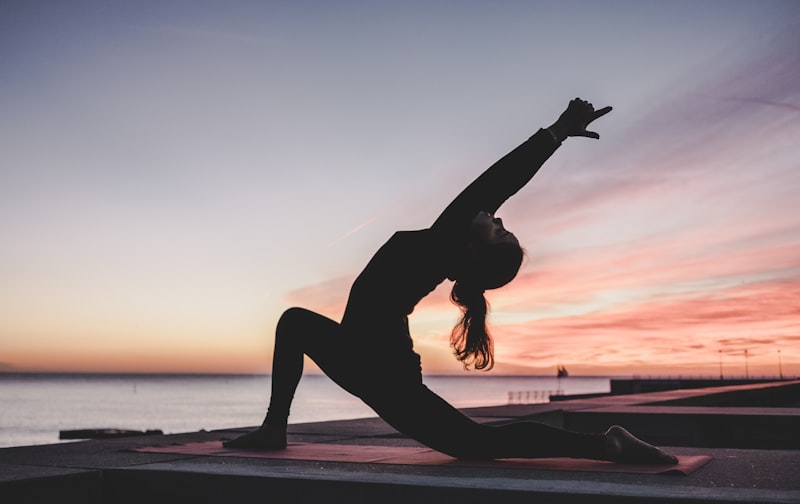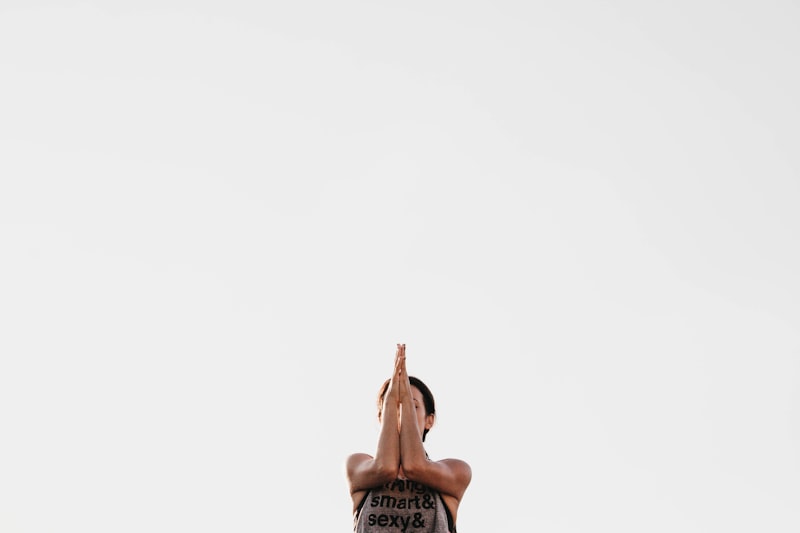One of the most effective yoga poses for tackling anxiety is the Child’s Pose, also known as Balasana. Picture this: you’re curled up like a little seed, knees drawn in, forehead resting gently on the mat. It’s a posture that encourages you to turn inward, letting go of tension in your body and mind.
If you’re looking to banish worries and quiet the mind, try the Standing Forward Bend or Uttanasana. As you fold forward, letting gravity do its work, you release tension in your spine and stretch out those tight hamstrings. It’s like hitting the reset button for your nervous system.
Another gem in the yoga treasure trove is the Legs-Up-the-Wall Pose, or Viparita Karani. Here’s the deal: you lie on your back with your legs extended up against a wall. This pose is fantastic for promoting relaxation and improving circulation. Plus, it’s a gentle inversion that helps to reverse the blood flow and calm your mind.
Now, let’s talk about the breath. Pranayama, or yogic breathing exercises, are powerful tools for managing anxiety. The Deep Belly Breathing technique, where you breathe deeply into your belly rather than shallowly into your chest, signals to your body that it’s time to unwind. It’s amazing how something as simple as focusing on your breath can melt away tension and bring clarity.
Last but not least, don’t underestimate the importance of Savasana, the Corpse Pose. This is your chance to completely surrender. You lie flat on your back, arms and legs relaxed, eyes closed. It’s the ultimate act of self-care, allowing your body and mind to integrate the benefits of your practice.
So there you have it – a handful of yoga practices that can work wonders for reducing anxiety. Whether you’re in need of a quick breather or a deeper reset, these poses and techniques are here to support you on your journey to calmness and clarity. Ready to roll out your mat and give them a try?
Zen in Motion: Mastering Yoga Poses to Calm Anxiety
Yoga isn’t just about stretching; it’s a journey inward, a dance between strength and surrender. It begins with the basics – the Mountain Pose, where you stand tall like a mountain, grounded yet reaching for the sky. As you inhale, feel your spine lengthen and your worries melt away. Exhale, and imagine releasing any stress that no longer serves you.
From there, you might move into the Warrior Pose series, embodying the courage and resilience of a warrior. Warrior I, II, and III invite you to connect with your inner strength while maintaining a sense of ease. Each posture encourages a deep connection with your breath, fostering a sense of calm amidst life’s challenges.
Balancing poses like Tree Pose or Eagle Pose challenge both body and mind, teaching focus and stability. As you find your center, notice how the mind follows suit, becoming more centered and clear. It’s like finding your balance on a surfboard amidst rolling waves – challenging yet exhilarating when achieved.
Inversions such as Downward Facing Dog or Headstand flip your perspective, quite literally. These poses offer a fresh outlook, allowing you to see the world from a new angle while enhancing circulation and calming the nervous system. Imagine hanging upside down from a tree branch, seeing the world with renewed curiosity and wonder.
Yoga is not a competition but a personal exploration. Each pose is an opportunity to listen to your body, honoring its strengths and limitations. Whether you’re a beginner or seasoned yogi, the journey is yours to savor. With practice, you’ll find that the true essence of yoga lies not in perfection but in the mindful union of breath, body, and spirit.
So, the next time anxiety creeps in, remember the power of “Zen in Motion”. Step onto your mat, breathe deeply, and let each pose guide you back to a place of inner peace and calm.
Mind Over Mat: How Yoga Nurtures Mental Well-being
In today’s fast-paced world, stress seems to be a constant companion. From deadlines at work to the endless chatter of social media, our minds rarely find a moment of peace. This is where yoga steps in as a gentle guide. Through its combination of postures, breathing exercises, and meditation, yoga offers a holistic approach to calming the mind.
Imagine yoga as a mental reset button. When you flow through the asanas, focusing on each movement and each breath, you’re allowing yourself to be fully present in the moment. This mindfulness practice not only reduces stress but also enhances concentration and clarity of thought.

One of the most remarkable aspects of yoga is its ability to balance emotions. Have you ever noticed how a few minutes of deep breathing can soothe feelings of anxiety or frustration? Yoga encourages us to observe our emotions without judgment, creating space for acceptance and inner peace.
Moreover, yoga stimulates the production of feel-good chemicals in the brain like serotonin and endorphins. These neurotransmitters play a crucial role in regulating mood and promoting a sense of well-being. It’s like giving your brain a natural happiness boost without any side effects.
Another profound benefit of yoga is its impact on sleep quality. By calming the nervous system and quieting the mind, yoga prepares the body for deep relaxation. A restful night’s sleep is not just a luxury but a necessity for mental and physical health.
Breathe Easy: Yoga Techniques That Combat Anxiety
Yoga isn’t just about striking poses on a mat; it’s a holistic practice that integrates breath, body, and mind. At its core, yoga teaches us to be present in the moment, which is crucial when anxiety tries to pull us into a whirlwind of worry. Through gentle movements and controlled breathing, yoga invites us to slow down and reconnect with our inner selves.
One powerful technique is deep diaphragmatic breathing, often called “belly breathing.” This involves inhaling deeply through your nose, allowing your belly to expand like a balloon, and exhaling slowly through your mouth. It sounds simple, but this rhythmic breathing activates the parasympathetic nervous system, triggering a relaxation response that counters anxiety’s fight-or-flight mode.
Have you ever felt tension melt away during a yoga class? That’s the magic of asanas, or yoga postures. Poses like Child’s Pose, where you kneel and bow forward with arms extended, gently stretch the spine and release tension from the shoulders and back. These physical movements not only increase flexibility and strength but also promote a sense of calm and well-being.
Imagine your anxiety as a stormy ocean. Yoga is your anchor, grounding you amidst turbulent waves. By focusing on your breath and body sensations, you can navigate through anxiety with grace and resilience. It’s not about erasing anxiety altogether but learning to coexist with it peacefully.
Incorporating yoga into your daily routine doesn’t require hours of dedication. Even a few minutes of mindful breathing or a couple of calming poses can make a world of difference. Consistency is key – the more you practice, the more effective it becomes in managing anxiety levels over time.
So, if anxiety has been knocking at your door, consider inviting yoga in. Embrace the practice with an open heart and a willingness to explore. Discover how something as simple as breathing deeply and moving mindfully can empower you to breathe easy and reclaim your inner calm.
Flowing Towards Peace: Yoga Sequences for Anxiety Relief

Yoga isn’t just about stretching and bending; it’s a holistic approach to wellness that combines breath and movement to soothe the soul. Whether you’re a seasoned yogi or a newbie, these sequences are tailored to help you find your zen, even in the midst of chaos.
Begin with a simple yet powerful breathing exercise. Close your eyes and take a deep inhale through your nose, feeling your lungs expand like a balloon. Then, exhale slowly through your mouth, letting go of tension with each breath. Repeat this cycle several times, allowing yourself to sink deeper into relaxation with every exhale.
Next, flow into a series of gentle asanas (poses) that target areas where stress tends to accumulate—the shoulders, neck, and hips. Start with Cat-Cow pose to warm up your spine, then transition into Child’s Pose to release tension in your lower back. Move through a sequence of Sun Salutations to awaken your body and connect with the rhythm of your breath.
As you flow through these movements, imagine each pose as a stepping stone on a peaceful riverbank, guiding you towards a tranquil lake of calmness. Let go of the need to be perfect and embrace the journey of self-discovery and healing that yoga offers.
Finish your practice with a relaxing Savasana, allowing your body to fully absorb the benefits of your practice. Close your eyes and let your mind drift like a leaf on a gentle stream, surrendering to the present moment without judgment or expectation.
Remember, the beauty of yoga lies in its ability to meet you where you are. Whether you practice for five minutes or fifty, each moment spent on your mat is an opportunity to reconnect with yourself and find inner peace. So, roll out your mat, take a deep breath, and let yoga guide you towards a calmer, more centered you.
Harnessing Serenity: The Top Yoga Poses for Anxiety Reduction
One of the most effective poses for anxiety reduction is the Child’s Pose, also known as Balasana. Imagine curling into a cozy, safe space where you can breathe deeply and let go of tension. This pose gently stretches the hips, thighs, and ankles while calming the brain and helping relieve stress and fatigue.
Another powerful posture in your anxiety-busting arsenal is the Legs Up the Wall Pose, or Viparita Karani. This pose might look simple, but its benefits are profound. By reversing the flow of gravity, Viparita Karani encourages relaxation, eases tension in the legs, and promotes circulation. It’s like hitting the reset button for your nervous system.
Let’s not forget about the Cat-Cow Pose, a dynamic duo that combines movement with breath. This sequence helps to synchronize your body and mind, fostering a sense of mindfulness and reducing anxiety. The gentle arching and rounding of the spine in Cat-Cow Pose massages the spine and helps calm the mind.
For those moments when anxiety feels overwhelming, the Corpse Pose, or Savasana, offers deep relaxation and renewal. Lying on your back, completely surrendering to the ground beneath you, allows both your body and mind to find peace. Savasana is a practice in letting go, releasing tension, and embracing stillness.
Incorporating these yoga poses into your daily routine can work wonders for reducing anxiety and promoting a sense of well-being. Whether you’re a seasoned yogi or a beginner, these poses offer accessible ways to cultivate serenity and inner peace. So, roll out your mat, breathe deeply, and let yoga guide you towards a calmer state of mind.
Frequently Asked Questions
What are some beginner-friendly yoga routines for anxiety?
Discover simple yoga routines designed for beginners to alleviate anxiety. These routines include gentle poses and calming breathing exercises to promote relaxation and reduce stress levels effectively.
How often should I practice yoga to alleviate anxiety symptoms?
Discover how often you should practice yoga to ease anxiety symptoms. Learn about the optimal frequency to experience the calming benefits of yoga.
How does yoga complement other therapies for managing anxiety?
Discover how yoga enhances anxiety management when used alongside other therapies. Learn about its synergistic benefits in promoting relaxation, reducing stress levels, and improving overall mental well-being.
What are the most effective yoga poses for reducing anxiety?
Discover effective yoga poses that help reduce anxiety by promoting relaxation and calmness. Learn simple techniques to manage anxiety through specific poses that focus on deep breathing and gentle stretching.
Can yoga breathing techniques help with anxiety relief?
Discover how yoga breathing techniques can effectively alleviate anxiety symptoms through controlled, mindful breathing exercises that promote relaxation and calmness.


